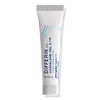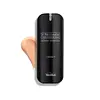What's inside
What's inside
 Key Ingredients
Key Ingredients

 Benefits
Benefits

 Concerns
Concerns

 Ingredients Side-by-side
Ingredients Side-by-side

Water
Skin ConditioningCaprylic/Capric Triglyceride
MaskingGlycerin
HumectantButylene Glycol
HumectantIsododecane
EmollientSqualane
EmollientCetearyl Alcohol
EmollientDimethicone
EmollientCetearyl Olivate
Sodium Acrylate/Sodium Acryloyldimethyl Taurate Copolymer
Emulsion StabilisingPolylactic Acid
AbrasiveCyclodextrin
AbsorbentPPG-12/Smdi Copolymer
EmollientSorbitan Olivate
EmulsifyingTitanium Dioxide
Cosmetic ColorantEclipta Prostrata Extract
Skin ConditioningPhenethyl Alcohol
MaskingMelia Azadirachta Leaf Extract
Skin ConditioningPhenoxyethanol
PreservativeCholesteryl Nonanoate
EmollientSodium Hyaluronate
HumectantTocopheryl Acetate
AntioxidantRubus Chamaemorus Seed Oil
Skin ConditioningCanola Oil
EmollientXanthan Gum
EmulsifyingPentylene Glycol
Skin ConditioningRetinal
Skin ConditioningRetinyl Retinoate
Skin ConditioningCitric Acid
BufferingAlumina
AbrasiveIsostearic Acid
CleansingLecithin
EmollientPolyglyceryl-3 Polyricinoleate
EmulsifyingPolyhydroxystearic Acid
EmulsifyingStearic Acid
CleansingCeramide AP
Skin ConditioningMoringa Oleifera Seed Oil
EmollientSodium Lauroyl Lactylate
EmulsifyingVanilla Planifolia Fruit Extract
Skin ConditioningEthylhexylglycerin
Skin ConditioningLinoleic Acid
CleansingPalmitic Acid
EmollientCeramide NP
Skin ConditioningDaucus Carota Sativa Seed Oil
EmollientDisodium EDTA
Phytosterols
Skin ConditioningLonicera Japonica Flower Extract
Skin Conditioning3-O-Ethyl Ascorbic Acid
Skin ConditioningLonicera Caprifolium Flower Extract
PerfumingSodium Polyaspartate
HumectantPhytosphingosine
Skin ConditioningParfum
MaskingCopper Palmitoyl Heptapeptide-14
Skin ConditioningHeptapeptide-15 Palmitate
Skin ConditioningCeramide EOP
Skin ConditioningCholesterol
EmollientC12-16 Alcohols
EmollientCaprylyl Glycol
EmollientCarbomer
Emulsion StabilisingHydrogenated Lecithin
EmulsifyingGlyceryl Caprylate
EmollientLactic Acid/Glycolic Acid Copolymer
Skin ConditioningPolyvinyl Alcohol
Phenylpropanol
MaskingBHT
AntioxidantLimonene
PerfumingLinalool
PerfumingCitral
PerfumingWater, Caprylic/Capric Triglyceride, Glycerin, Butylene Glycol, Isododecane, Squalane, Cetearyl Alcohol, Dimethicone, Cetearyl Olivate, Sodium Acrylate/Sodium Acryloyldimethyl Taurate Copolymer, Polylactic Acid, Cyclodextrin, PPG-12/Smdi Copolymer, Sorbitan Olivate, Titanium Dioxide, Eclipta Prostrata Extract, Phenethyl Alcohol, Melia Azadirachta Leaf Extract, Phenoxyethanol, Cholesteryl Nonanoate, Sodium Hyaluronate, Tocopheryl Acetate, Rubus Chamaemorus Seed Oil, Canola Oil, Xanthan Gum, Pentylene Glycol, Retinal, Retinyl Retinoate, Citric Acid, Alumina, Isostearic Acid, Lecithin, Polyglyceryl-3 Polyricinoleate, Polyhydroxystearic Acid, Stearic Acid, Ceramide AP, Moringa Oleifera Seed Oil, Sodium Lauroyl Lactylate, Vanilla Planifolia Fruit Extract, Ethylhexylglycerin, Linoleic Acid, Palmitic Acid, Ceramide NP, Daucus Carota Sativa Seed Oil, Disodium EDTA, Phytosterols, Lonicera Japonica Flower Extract, 3-O-Ethyl Ascorbic Acid, Lonicera Caprifolium Flower Extract, Sodium Polyaspartate, Phytosphingosine, Parfum, Copper Palmitoyl Heptapeptide-14, Heptapeptide-15 Palmitate, Ceramide EOP, Cholesterol, C12-16 Alcohols, Caprylyl Glycol, Carbomer, Hydrogenated Lecithin, Glyceryl Caprylate, Lactic Acid/Glycolic Acid Copolymer, Polyvinyl Alcohol, Phenylpropanol, BHT, Limonene, Linalool, Citral
 Reviews
Reviews

Ingredients Explained
These ingredients are found in both products.
Ingredients higher up in an ingredient list are typically present in a larger amount.
Carbomer is a polymer of acrylic acid. Its main role is to create a gel consistency.
A high amount of carbomer can cause pilling or balling up of products. Don't worry, most products contain 1% or less of carbomer.
Disodium EDTA plays a role in making products more stable by aiding other preservatives.
It is a chelating agent, meaning it neutralizes metal ions that may be found in a product.
Disodium EDTA is a salt of edetic acid and is found to be safe in cosmetic ingredients.
Learn more about Disodium EDTAWater. It's the most common cosmetic ingredient of all. You'll usually see it at the top of ingredient lists, meaning that it makes up the largest part of the product.
So why is it so popular? Water most often acts as a solvent - this means that it helps dissolve other ingredients into the formulation.
You'll also recognize water as that liquid we all need to stay alive. If you see this, drink a glass of water. Stay hydrated!
Learn more about Water